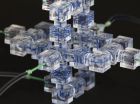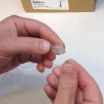(Press-News.org) Thanks to new LEGO®-like components developed by researchers at the USC Viterbi School of Engineering, it is now possible to build a 3-D microfluidic system quickly and cheaply by simply snapping together small modules by hand.
Microfluidic systems are used in many fields including engineering, chemistry and biotechnology to precisely manipulate small volumes of fluids for use in applications such as enzymatic or DNA analysis, pathogen detection, clinical diagnostic testing, and synthetic chemistry. Traditionally, microfluidic devices are built in a cleanroom on a two-dimensional surface using the same technology developed to produce integrated circuits for the electronics industry.
Though tiny, designing, assembling and testing a new microfluidics system can take a lot of time and money. Building a single device can often require multiple iterations, each of which can take up to two weeks and several thousand dollars to manufacture. And the more complex the system, the higher the number of iterations needed.
"You test your device and it never works the first time," said Krisna Bhargava, materials science graduate student at the USC Viterbi School of Engineering. "If you've grown up to be an engineer or scientist, you've probably been influenced by LEGO® at some point in your childhood. I think every scientist has a secret fantasy that whatever they're building will be as simple to assemble."
Frustrated that reproducing a simple microfluidic circuit could cost him so much time and money, Bhargava set out simplify the construction process. First, he identified the primitive elements commonly used in microfluidic systems, much like how circuitry is broken down in electrical engineering. Basic microfluidic functions would be separated into standardized modular components, not an entirely revolutionary concept. But then, he abandoned the two-dimensional method of building microfluidic devices altogether.
"The founders of the microfluidics field took the same approach as the semiconductor industry: to try to pack in as much integrated structure as possible into a single chip," explained Bhargava. "In electronics, this is important because a high density of transistors has many direct and indirect benefits for computation and signal processing. In microfluidics, our concerns are not with bits and symbolic representations, but rather with the way fluidics are routed, combined, mixed, and analyzed; there's no need to stick with continuing to integrate more and more complex devices."
Borrowing an approach from the electronics industry, which uses prototype boards to build circuits, Bhargava conceived of three-dimensional modular components that encapsulated the common elements of microfluidic systems, as well as a connector that could join the separate components together. Inspired by recent advancements in micron-scale 3D-printing, he and a USC Viterbi research team that included chemical engineering and materials science professor Noah Malmstadt and biomedical engineering graduate student Bryant Thompson, designed computer models for eight modular fluidic and instrumentation components (MFICs, pronounced "em-fix") that would each perform a simple operation. Examples are a "helix" component that can mix two fluid streams and a component that contains an integrated optical sensor for measuring the size of small droplets. The components constructed for this study are approximately 1 cm3, slightly smaller than a standard 6-sided die.
The team's development of these MFICs represents the first attempt to break a device into separate components that can be assembled, disassembled and re-assembled over and over.
"What we've built looks more like a hobby breadboard," said Malmstadt. "You can build a circuit on the cheap with your bare hands."
The team attributes much of the success in the fabrication stage to recent advancements in high-resolution 3-D printing.
"We got the parts back from our contract manufacturer and on the first try they worked out better than I could have dreamed. We were able to build a working microfluidic system that day, as simple as clicking LEGO® blocks together," said Bhargava.
Using the 3-D-printed MFICs, in a matter of hours the team was able to build and test a device that mixed fluids using a helix component and turned the mixture into droplets. Essentially a very long track packed into the same standardized module footprint, the helix component allows adjustments in flow resistance or can serve as an efficient mixer. In microfluidic systems, mixing is dominated by diffusion, and a complex helix can speed up the process by folding the fluid onto itself.
"Trying to control how things mix has always been a major issue in this field just due to the way that fluids flow at very small dimensions," explained Malmstadt. "People have come up with all sorts of ways to twist and turn the channels to try to improve the mixing. The fact that we can do it in three dimensions with this 3-D helix really simplifies things."
Such work lies at the heart of the convergence of science and engineering at USC, where researchers from both fields collaborate to create the tools that make scientific breakthroughs possible.
The team reports their recent invention in "Discrete Elements for 3-D Microfluidics," published in Proceedings of the National Academy of Sciences (PNAS) of the United States of America on September 22. In the paper, the researchers also described how off-the-shelf sensors or other integrated components can be easily incorporated into systems built from MFICs, and demonstrated how the MFICs can size droplets precisely, a useful function for drug delivery or studying microreactor chambers. In detecting droplet size, they found that a 30-cent component yielded results comparable to those from the traditional tool, a $30,000-plus optical microscope.
The result is an extremely cheap, standardized, easy-to-use set of components that can quickly be assembled and re-assembled into a microfluidic system for a mere fraction of the time and cost it currently takes to produce a device to perform the same operation.
"You pull out everything you think is going to work, you stick it together and you test it," said Bhargava. "If it doesn't work, you pull part of it out, swap out some pieces and within a day you've probably come to a final design, and then you can seal the system together and make it permanent. You have a massive productivity gain and a huge cost advantage."
For the past 20 years, microfluidics has been considered a boon for fields like biotechnology and engineering, but has yet to be standardized or universally adopted by the wider community of researchers and in industry. The technology, often dubbed "Lab-on-Chip", has the potential to accelerate the pace of development and provide the means for high-precision experiments to be carried out in low-resource settings. The USC Viterbi team's goal is to finally help that happen.
"MFICs will vastly increase the productivity of a single grad student, postdoc, or lab tech by enabling them to build their own instruments right in the lab and automate their workflow, saving time and money," said Malmstadt. "I think of it as a technological approach to the STEM shortage – make each researcher more powerful by enabling them to do their own automation without having to be an expert in mircrofabrication or having the capability to design complex integrated devices."
The team envisions an open community where designs can be shared via an open-source database. They have plans to develop more components and hope that other researchers will begin using MFICs for their own experiments as well as contribute to the development of new components and systems that will help speed advancements in the microfluidic research community.
"People have done great things with microfluidics technology, but these modular components require a lot less expertise to design and build a system," said Malmstadt. "A move toward standardization will mean more people will use it, and the more you increase the size of the community, the better the tools will become."
INFORMATION:
This research was partially funded by the National Institutes of Health (Award 1R01GM093279).
About the USC Viterbi School of Engineering
Engineering Studies began at the University of Southern California in 1905. Nearly a century later, the Viterbi School of Engineering received a naming gift in 2004 from alumnus Andrew J. Viterbi and his wife Erna. Viterbi is the inventor of the Viterbi algorithm, now key to cell phone technology and numerous data applications. Consistently ranked among the top graduate programs in the world, the school enrolls more than 5,000 undergraduate and graduate students, taught by more than 174 tenured and tenure-track faculty, with 60 endowed chairs and professorships. http://viterbi.usc.edu
Lego-like modular components make building 3-D 'labs-on-a-chip' a snap
Newly developed modular components take microfluidic system construction from flat to 3-D and make it cheap, quick and easy
2014-09-22
ELSE PRESS RELEASES FROM THIS DATE:
Platelets modulate clotting behavior by 'feeling' their surroundings
2014-09-22
Platelets, the tiny cell fragments whose job it is to stop bleeding, are very simple. They don't have a cell nucleus. But they can "feel" the physical environment around them, researchers at Emory and Georgia Tech have discovered.
Platelets respond to surfaces with greater stiffness by increasing their stickiness, the degree to which they "turn on" other platelets and other components of the clotting system, the researchers found.
"Platelets are smarter than we give them credit for, in that they are able to sense the physical characteristics of their environment and ...
Genetic switch regulates a plant's internal clock based on temperature
2014-09-22
Scientists have discovered a key molecular cog in a plant's biological clock – one that modulates the speed of circadian (daily) rhythms based on temperature.
Transcription factors, or genetic switches, drive gene expression in plants based on external stresses – such as light, rain, soil quality, or even animals grazing on them. A team of researchers at USC has isolated one, called FBH1, that reacts to temperature – tweaking the rhythm here and there as needed while in keeping it on a consistent track.
"Temperature helps keep the hands of the biological clock in the ...
Massachusetts General study reveals gene expression patterns in pancreatic CTCs
2014-09-22
Analysis of circulating tumor cells (CTCs) in a mouse model of pancreatic cancer identified distinct patterns of gene expression in several groups of CTCs, including significant differences from the primary tumor that may contribute to the ability to generate metastases. In their study reported in the Sept. 25 issue of Cell Reports, investigators from the Massachusetts General Hospital (MGH) Cancer Center identified several different classes of pancreatic CTCs and found unexpected factors that may prove to be targets for improved treatment of the deadly tumor.
"Our ...
Infant solar system shows signs of windy weather
2014-09-22
Astronomers using the Atacama Large Millimeter/submillimeter Array (ALMA) have observed what may be the first-ever signs of windy weather around a T Tauri star, an infant analog of our own Sun. This may help explain why some T Tauri stars have disks that glow weirdly in infrared light while others shine in a more expected fashion.
T Tauri stars are the infant versions of stars like our Sun. They are relatively normal, medium-size stars that are surrounded by the raw materials to build both rocky and gaseous planets. Though nearly invisible in optical light, these disks ...
Old drug may be key to new antibiotics
2014-09-22
Hamilton, ON (September 22, 2014) – McMaster scientists have found that an anticonvulsant drug may help in developing a new class of antibiotics.
Although dozens of antibiotics target what bacteria do, their study has looked at how a certain part of bacteria are created, and they found there is a way of stopping it.
The discovery is important as there is growing concern worldwide about how antibiotic resistance is making the cures for infections ineffective. The World Health Organization has declared that antibiotic resistance is a major threat to global health security. ...
Answer to restoring lost island biodiversity found in fossils
2014-09-22
GAINESVILLE, Fla. --- Many native species have vanished from tropical islands because of human impact, but University of Florida scientists have discovered how fossils can be used to restore lost biodiversity.
The key lies in organic materials found in fossil bones, which contain evidence for how ancient ecosystems functioned, according to a new study available online and in the September issue of the Journal of Herpetology. Pre-human island ecosystems provide vital clues for saving endangered island species and re-establishing native species, said lead author Alex Hastings, ...
Higher risk of heart disease for South Asians in Canada
2014-09-22
Hamilton, ON (September 22, 2014) – South Asians living in Canada have a higher rate of heart disease and double the rate of diabetes compared with while people, McMaster researchers have found.
The paper was published today in the Canadian Medical Association Journal (CMAJ Open) and may be found at http://www.cmajopen.ca/content/2/3/E183.full
One of the fastest-growing ethnic groups in the country is the more than one million South Asian people living in Canada, comprising about three percent of the population. They include people from India, Pakistan, Sri Lanka, ...
Snail shells show high-rise plateau is much lower than it used to be
2014-09-22
The Tibetan Plateau in south-central Asia, because of its size, elevation and impact on climate, is one of the world's greatest geological oddities.
At about 960,000 square miles it covers slightly more land area than Alaska, Texas and California combined, and its elevation is on the same scale as Mount Rainier in the Cascade Range of Washington state. Because it rises so high into the atmosphere, it helps bring monsoons over India and other nations to the south while the plateau itself remains generally arid.
For decades, geologists have debated when and how the plateau ...
Cheater, cheater: UGA study shows what happens when employees feel excluded at work
2014-09-22
Athens, Ga. – When employees feel left out, they act out.
That's the message that new research from the University of Georgia Terry College of Business delivers as it explains why employees can become weasels to benefit their work group.
"Everybody has a need for social approval. It's the basis of our human functioning," said Marie Mitchell, co-author of the research and professor of management at UGA. "But when individuals are faced with a risk of social exclusion, it motivates some pretty unsavory behaviors. We already know how people react when they're definitely ...
Reversing the effects of pulmonary fibrosis
2014-09-22
New Haven, Conn. – Yale University researchers are studying a potential new treatment that reverses the effects of pulmonary fibrosis, a respiratory disease in which scars develop in the lungs and severely hamper breathing.
The treatment uses a microRNA mimic, miR-29, which is delivered to lung tissue intravenously. In mouse models, miR-29 not only blocked pulmonary fibrosis, it reversed fibrosis after several days.
The findings were published Sept. 19 in the journal EMBO Molecular Medicine.
"The mimic, when injected into the blood, goes to the lung and it has a ...
LAST 30 PRESS RELEASES:
Why nail-biting, procrastination and other self-sabotaging behaviors are rooted in survival instincts
Regional variations in mechanical properties of porcine leptomeninges
Artificial empathy in therapy and healthcare: advancements in interpersonal interaction technologies
Why some brains switch gears more efficiently than others
UVA’s Jundong Li wins ICDM’S 2025 Tao Li Award for data mining, machine learning
UVA’s low-power, high-performance computer power player Mircea Stan earns National Academy of Inventors fellowship
Not playing by the rules: USU researcher explores filamentous algae dynamics in rivers
Do our body clocks influence our risk of dementia?
Anthropologists offer new evidence of bipedalism in long-debated fossil discovery
Safer receipt paper from wood
Dosage-sensitive genes suggest no whole-genome duplications in ancestral angiosperm
First ancient human herpesvirus genomes document their deep history with humans
Why Some Bacteria Survive Antibiotics and How to Stop Them - New study reveals that bacteria can survive antibiotic treatment through two fundamentally different “shutdown modes”
UCLA study links scar healing to dangerous placenta condition
CHANGE-seq-BE finds off-target changes in the genome from base editors
The Journal of Nuclear Medicine Ahead-of-Print Tip Sheet: January 2, 2026
Delayed or absent first dose of measles, mumps, and rubella vaccination
Trends in US preterm birth rates by household income and race and ethnicity
Study identifies potential biomarker linked to progression and brain inflammation in multiple sclerosis
Many mothers in Norway do not show up for postnatal check-ups
Researchers want to find out why quick clay is so unstable
Superradiant spins show teamwork at the quantum scale
Cleveland Clinic Research links tumor bacteria to immunotherapy resistance in head and neck cancer
First Editorial of 2026: Resisting AI slop
Joint ground- and space-based observations reveal Saturn-mass rogue planet
Inheritable genetic variant offers protection against blood cancer risk and progression
Pigs settled Pacific islands alongside early human voyagers
A Coral reef’s daily pulse reshapes microbes in surrounding waters
EAST Tokamak experiments exceed plasma density limit, offering new approach to fusion ignition
Groundbreaking discovery reveals Africa’s oldest cremation pyre and complex ritual practices
[Press-News.org] Lego-like modular components make building 3-D 'labs-on-a-chip' a snapNewly developed modular components take microfluidic system construction from flat to 3-D and make it cheap, quick and easy








